The Shanghai Bund
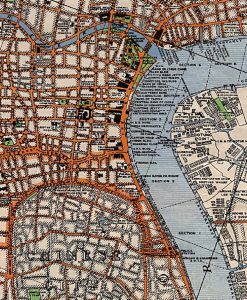
The Bund (外滩) is a famous and historical waterfront area in central Shanghai, typically referring to the iconic buildings and boardwalk. The Bund stretches two kilometers along the riverbank, traditionally beginning at Yan’an Road in the south and ending at Waibaidu Bridge in the north.
The Bund is on the western bank of the Huangpu River and faces the skyscrapers of Pudong New District. At night the skyscrapers are illuminated with dazzling lights and has become an icon of the city.
The word bund means an embankment. It’s an old word with Persian origins. The Chinese name for the Bund is Wàitān which means “outer beach”.
The Shanghai Bund has dozens of historical buildings, which once housed banks and trading houses of the major financial institutions operating in China. Here is a brief overview of the highlights and at the end are links to resources if you want more information.
Start at Jinling East Road Ferry
金陵东路轮渡站
My regular trek to The Bund starts across the river on the Pudong side of Shanghai. A short walk takes me to the ferry terminal off Dongchang Lu, where I use my metro card for the relatively scenic ride across the river.
Arriving at the southernmost point of the Bund, I could also take a short walk to the Hotel Indigo and its rooftop bar. On a clear day or night, that is also worth a visit for a drink (or two) while enjoying the city views.
From this ferry landing point or anywhere along the way, be prepared for your stroll alongside throngs of Chinese and foreign tourists, especially during national holidays when the masses flock to Shanghai. You’ll have lots of photo ops along the way, whether it be of the historic buildings, boats navigating the river, mega-skyline of Pudong, or even of you (if you are a “Westerner,” be prepared for a few head turns and possible requests for self-stick posed pictures).
The Bund Signal Tower
外滩信号台
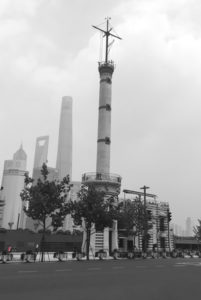
The Bund Signal Tower 外滩信号台 was first built by the French in 1865. The tower signaled weather reports five times a day and gave emergency flag signals in case of typhoon or sudden inclement weather. Its operation was discontinued in 1956. There used to be a history museum and a cafe inside but I don’t think it is open any longer.
See also: Bund Signal Tower Geocache
Shanghai Pudong Development Bank
上海浦东发展银行
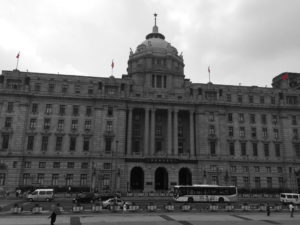
Shanghai Pudong Development Bank Co. Ltd, incorporated in 1993 has its headquarters located in Shanghai. Formally the bank here was the Hongkong and Shanghai Banking Corporation (HSBC).
The purpose of SPDB is to provide financial services for the development of Pudong.
Regardless of which bank is here, the building is one of the most recognized on the Bund and has become a central icon.
The Customs House
江海关
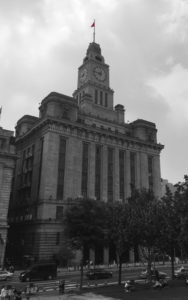
The Customs House 江海关 was built in 1927 and remains a customs house today. The original Shanghai Customs House was first set up in the late 17th century to facilitate trading along the east coast of China.
The Customs House and Shanghai Pudong Development Bank together are often pictured as the symbol of the Bund and Shanghai.
Fairmont Peace Hotel
和平饭店
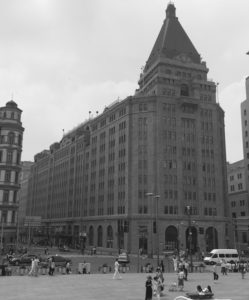
The Peace Hotel 和平饭店 overlooks the Huangpu River. The hotel today operates as two separate businesses. The North Building, built as Sassoon House, originally housed the Cathay Hotel and is today the Fairmont Peace Hotel run by Fairmont Hotels and Resorts of Canada. The South Building was built as the Palace Hotel and is today the Swatch Art Peace Hotel. The two buildings both face the Bund, but are divided by Nanjing Road.
An old building with elegance and character, including a large glass ceiling in the rotunda, many rich and famous people have visited this landmark.
Huangpu Park
黄浦公园
Huangpu Park 黄浦公园 refers to the triangular stretch of green at the northern end of the Bund, the oldest and smallest park of the city. It is the site of the large Monument to the People’s Heroes, commemorating those who helped to free China from foreign occupation, and of the Bund Historical Museum, which documents the history of the Bund in old photographs.
The first park located here was established in 1886 with the simple name “Public Garden,” representing the first park in China open to the public. Designed by a Scottish gardener in European style, it included a resting pavilion and a tennis court, aiming at the increasing number of foreigners living in Shanghai since the city had become an international trade port in the 1840s.
The Public Garden was closed to Chinese people between 1890 and 1928 and, according to a popular myth, a sign at the park’s gate read “No dogs or Chinese allowed.” However, period photographs show a sign listing ten regulations, the first of which was “The Gardens are reserved for the Foreign Community,” with the fourth being “Dogs and bicycles are not admitted.”
In any case, the banning of Chinese from Huangpu Park and other parks in China has remained in Chinese public mind as one of the many examples of the country’s humiliation by the Western powers in the 19th and early 20th century. The legend was even manifested in the Bruce Lee film Fist of Fury, where a scene taking place at Huangpu Park gate features a “No dogs and Chinese allowed” sign.
Monument to the People’s Heroes
上海市人民英雄纪念塔
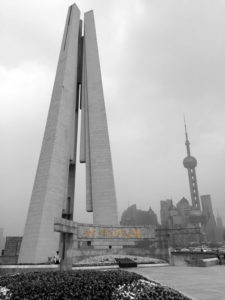
The Monument to the People’s Heroes 上海市人民英雄纪念塔 was built by the Shanghai municipal government in the 1993 to commemorate revolutionary martyrs (See also Longhua Temple), as well as those who have lost their lives fighting natural disasters.
The structure stands 24 metres tall, and is built in the stylised shape of three rifles leaning against each other. The Monument is surrounded by a paved space used by locals for morning exercises.
Waibaidu Bridge
外白渡桥
The Waibaidu Bridge 外白渡桥, was the first all-steel bridge and the only surviving example in China of a camelback truss bridge. The present bridge was opened on 20 January 1908.
People regard this bridge as something special because its old age is a juxtaposition with the city that has rapidly changed around it.
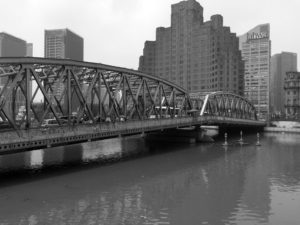
Resources: Wikipedia, Wikitravel, TripAdvisor